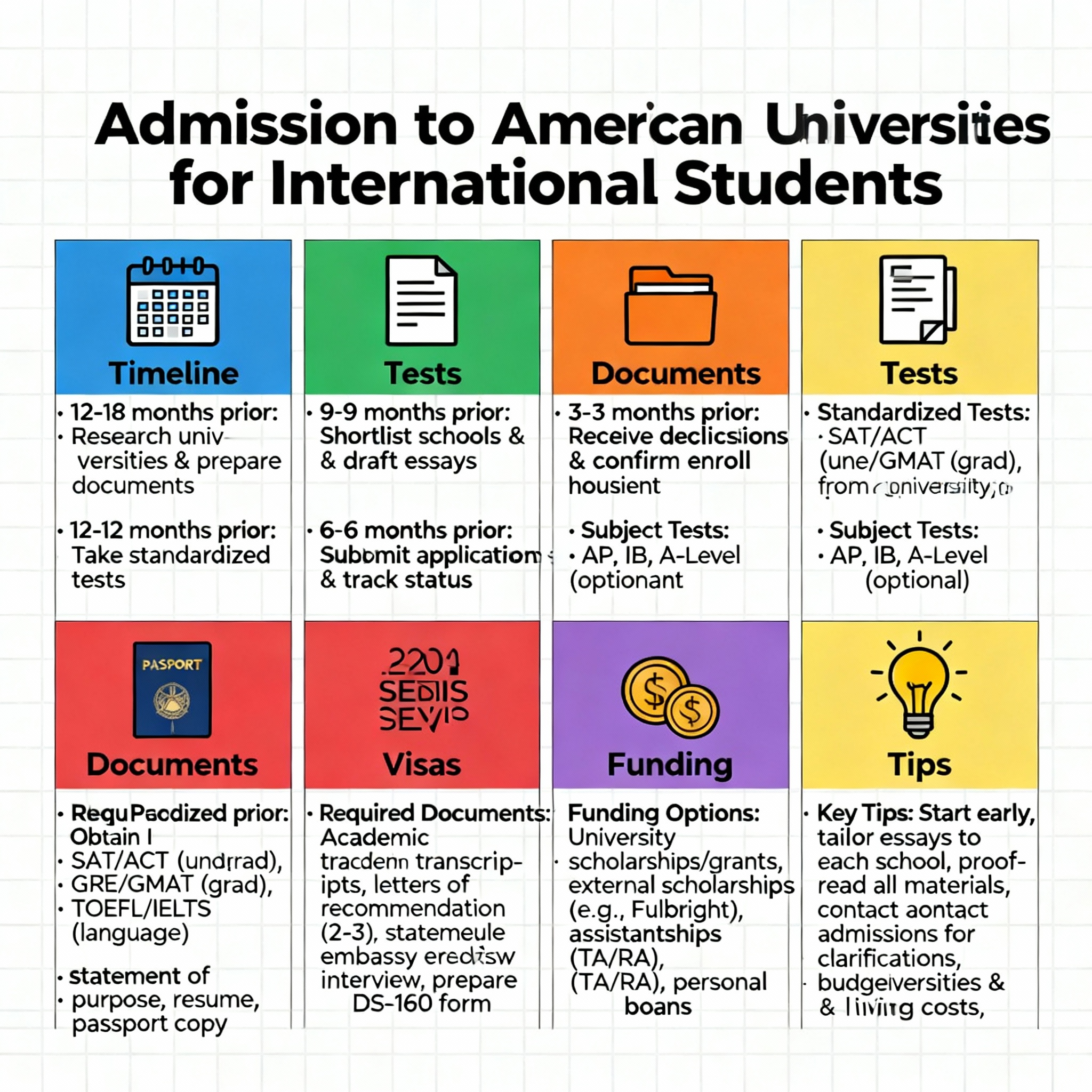A Detailed Guide for International Students on ” How to apply for admission to American Universities”
1. Research and Shortlist Universities (12–18 months before applying for admission to American Universities)
-
Identify academic goals: Choose your field of study (e.g., Engineering, Business, Arts).
-
Decide on the level of education:
-
Undergraduate (Bachelor’s Degree)
-
Graduate (Master’s/Ph.D.)
-
-
Search for universities that fit:
-
Academic strengths and curriculum
-
Rankings, location, tuition cost, and student life
-
-
Use trusted sources:
-
Official university websites
-
U.S. News & World Report, QS Rankings, College Board
-
-
Create a shortlist:
-
Apply to a mix of “dream,” “match,” and “safe” schools (usually 5–10 total)
-
📝 2. Understand Admission Requirements
-
General requirements before applying for admissions:
-
Completed application form (online via Common App, Coalition App, or university portal)
-
Academic transcripts (high school or prior university records)
-
Letters of recommendation (typically 2–3)
-
Standardized test scores (if required)
-
Statement of Purpose / Personal essay
-
Resume or CV (especially for graduate applications)
-
English language proficiency test scores (TOEFL, IELTS, or Duolingo)
-
-
Additional for certain programs:
-
Portfolio (Art, Architecture, Design)
-
GRE/GMAT for graduate programs
-
Research proposal (Ph.D.)
-
🧾 3. Prepare for and Take Standardized Tests
-
Undergraduate level:
-
SAT or ACT (optional at many schools since COVID-19, but still accepted)
-
-
Graduate level:
-
GRE (general test; required by many STEM and social science programs)
-
GMAT (business schools)
-
-
English Proficiency:
-
TOEFL: Widely accepted
-
IELTS: Also accepted by most U.S. universities
-
Duolingo English Test: Accepted by an increasing number of schools
-
-
Tips:
-
Start preparing at least 6–9 months in advance
-
Register for tests early to secure seats and receive scores on time
-
Aim to take tests 6–12 months before the application deadline
-
🗓️ 4. Track Application Deadlines
-
Fall intake (August–September) is the most common
-
Application types:
-
Early Decision (ED): Binding, usually due in Nov
-
Early Action (EA): Non-binding, also in Nov
-
Regular Decision (RD): Due around Jan 1–Feb 1
-
Rolling Admission: Open until all seats are filled
-
-
Graduate deadlines vary:
-
Often between December and March depending on program
-
-
Set reminders to avoid missing:
-
Application deadlines
-
Test registration dates
-
Scholarship or financial aid forms (e.g., CSS Profile)
-
✍️ 5. Write Personal Statements and Essays
-
Undergraduate:
-
Common App essay (650 words): Choose from prompts
-
Supplementary essays: “Why this college?” or “What will you contribute?”
-
-
Graduate:
-
Statement of Purpose (SOP): Focus on academic/professional background, goals, why the program fits
-
Tailor essays to each program
-
-
Tips:
-
Start drafts early and revise
-
Avoid clichés, focus on personal experiences
-
Ask teachers, counselors, or mentors for feedback
-
📚 6. Secure Transcripts and Recommendations
-
Request official transcripts:
-
From high school or previous colleges/universities
-
May need to be translated and/or evaluated (e.g., via WES)
-
-
Letters of Recommendation:
-
Ask teachers/professors who know you well
-
Provide them with your resume and a summary of your achievements
-
Give at least 3–4 weeks’ notice
-
💸 7. Financial Planning & Aid
-
Tuition & Costs:
-
Vary widely ($15,000–$60,000/year)
-
Include housing, meals, books, insurance
-
-
Apply for Scholarships:
-
University-based merit scholarships
-
Need-based aid (e.g., CSS Profile)
-
External scholarships (e.g., Fulbright, Inlaks, Tata Trusts)
-
-
Assistantships (for graduates):
-
Teaching Assistant (TA) or Research Assistant (RA) positions
-
Apply early and express interest in SOP or emails to faculty
-
🌐 8. Submit Applications
-
Choose platform:
-
Common App (for undergrad, used by 900+ schools)
-
University portals (especially for graduate programs)
-
-
Pay application fee:
-
Typically $50–$100 per university
-
Fee waivers may be available for financial need
-
-
Check for confirmation emails and log-in portals:
-
Universities usually provide a checklist and updates
-
📩 9. Attend Interviews (if required)
-
Undergraduate interviews:
-
Not always required; may be evaluative or informational
-
-
Graduate interviews:
-
Often conducted by faculty or admissions committees
-
-
Tips:
-
Be prepared to discuss your goals, background, and interest in the program
-
Practice common questions
-
Dress professionally (even for virtual interviews)
-
📬 10. Await Results & Respond
-
Admission decisions typically released:
-
Early Action/Decision: December–January
-
Regular Decision: March–April
-
-
Decision types:
-
Admitted
-
Waitlisted
-
Rejected
-
-
Respond by May 1 (national decision deadline for undergrad)
-
Graduate offers: Follow deadlines in offer letters (usually April 15)
🛂 11. Apply for Student Visa (F-1 or J-1)
-
Receive Form I-20 from your university (needed to apply for F-1 Visa)
-
Pay SEVIS fee ($350) and schedule visa interview at U.S. Embassy or Consulate
-
Prepare visa documents:
-
I-20 form
-
Passport
-
Visa application form (DS-160)
-
Proof of financial support
-
Admission letter
-
Academic transcripts and test scores
-
-
Visa Interview Tips:
-
Be honest and concise
-
Clearly explain study plans and ties to home country
-
✈️ 12. Pre-Departure Preparation
-
Book travel: Once visa is approved
-
Arrange housing: On-campus or off-campus
-
Health insurance: Often mandatory; check with university
-
Attend university orientation: Many offer online or pre-arrival sessions
-
Pack essentials: Documents, medication, adapters, etc.
🎯 Summary of Timeline (to apply for admission to American Universities)
| Month | Activity |
|---|---|
| April–June | Research universities, start test prep |
| July–Sept | Take TOEFL/IELTS, SAT/GRE, draft SOP/essays |
| Oct–Dec | Submit applications (Early & Regular) |
| Jan–March | Complete remaining applications |
| March–April | Receive offers, apply for scholarships |
| May–June | Accept offers, get I-20, apply for visa |
| July–August | Fly to U.S., attend orientation, start classes |








